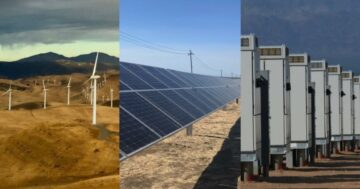
Global government and private sector leaders are descending on Dubai as COP28 kicks off. Finding a consensus on how to fix climate finance is high on the conference agenda.
A zero-carbon world isn’t feasible "without major reform of the current financial system," said COP28 President-designate Sultan Al Jaber earlier this year. "However … creating a better climate finance system can catalyze the biggest economic transformation since the Industrial Revolution."
COP28 is taking place at a pivotal moment. Oil and gas majors have continued to invest in new production, out of step with the Paris Agreement goal of holding global temperature increases under 1.5 degrees Celsius.
The feasibility of "keeping 1.5 alive" appears increasingly tenuous. 2023 saw the hottest month on record since 1880, and the global average temperature briefly passed 2 degrees Celsius of warming from the pre-industrial era for the first time in mid-November.
A turning point?
It will require an estimated $4 trillion annually by 2030 to transition to a clean economy that reverses those trends, and Al Jaber has noted that the money isn’t flowing fast enough.
It will take a real step change at COP28 to rewrite that equation, said Elise Larkin, director of global economic recovery at The Rockefeller Foundation.
First, the investment community needs concrete evidence that developed countries have fulfilled their promise to mobilize $100 billion a year in climate finance for low- and middle-income countries, a commitment made in 2009 at COP15.
Public- and private-sector investors are also seeking more details about an agreement to operationalize the "loss and damage" fund established during COP27 in Egypt. The fund would provide financing from developed countries to developing countries already experiencing acute impacts of a changing climate.
Consensus around an initial proposal for the fund was reached in the leadup to Dubai, but there’s likely to be ongoing debate as to where the fund will be hosted after the interim hosting period by the World Bank in Washington, D.C. There are also questions about which countries should contribute to the fund and which countries should be able to access it.
Taking stock of progress
The weeks ahead should leave us with the most comprehensive inventory of the flow of climate finance, especially to developing countries where it is most needed. The first Paris Agreement Global Stocktake, an evaluation of the world's progress toward the Paris Agreement goals, is set to conclude at COP28.
Assessments of the climate finance gap vary by trillions of dollars, given the lack of solid definitions or centralized oversight in tracking climate finance flows.
But according to a report released in September by the Climate Policy Initiative (CPI), a think tank considered to be a leading expert in tracking global climate finance, we’ll need $6.2 trillion of climate finance by 2030 to tackle climate change — nearly $1 trillion a year.
Over the past decade, the cumulative investments have amounted to just $1 trillion, per CPI’s analysis.
Wanted: More private sector contributions
The pool of climate finance available for deployment won’t get deeper unless more institutional investors dive in — after all, they represent more than $70 trillion in global investable assets.
The key to encouraging more participation is to find innovative means of reducing risk: Institutional investors are largely averse to higher risk given that their fiduciary duty pushes them to choose less risky projects in developed markets.
Blended financing — models that use risk-tolerant development, philanthropic or public finance to mobilize private investment in emerging markets — can alter the risk-return profile for the climate transition in developing countries.
So far, most climate finance has been focused on mitigation. Rightly so, since emissions need to be reduced rapidly to slow down climate change.
Despite the risk hurdles for institutional investors, mitigation finance also comes with an established business case. Investment in clean energy projects, for example, provides a future revenue stream through the sale of generated energy.
Adaptation investments — such as seawalls to protect coastal communities from rising sea levels — lack that clear revenue stream. That makes the business case tougher to argue.
But, in a world that has had its first brief encounter with a 2 degrees Celsius future, adaptation finance can’t remain sidelined.
A report about climate finance funding flows from The Rockefeller Foundation and Boston Consulting Group found that adaptation and resilience projects receive about one-tenth of the $410 billion to $560 billion in annual financing they require.
"There needs to be new commercial, private-public partnerships on adaptation, and we're not really yet seeing this," said Matthew Reddy, senior private sector specialist at the Global Environment Facility, a multilateral environmental fund.
One example of a public-private partnership focused on adaptation comes from the World Bank’s Multilateral Investment Guarantee Agency, which has covered country and contract risks to encourage investment in Jordan. The agency guaranteed $13.1 million of protected equity investments by private investors, allowing them to finance the expansion of an existing water treatment plant to provide resilience against drought, sea-level rise and saltwater intrusion.
At COP28, the best outcome for climate finance can be distilled to this statement: More, and now. The discussions ahead will hopefully delve deep into who will pay and how much — not what should or shouldn’t be paid for. The climate bill is coming due.
- SEO Powered Content & PR Distribution. Get Amplified Today.
- PlatoData.Network Vertical Generative Ai. Empower Yourself. Access Here.
- PlatoAiStream. Web3 Intelligence. Knowledge Amplified. Access Here.
- PlatoESG. Carbon, CleanTech, Energy, Environment, Solar, Waste Management. Access Here.
- PlatoHealth. Biotech and Clinical Trials Intelligence. Access Here.
- Source: https://www.greenbiz.com/article/why-cop28-pivotal-moment-climate-finance
- :has
- :is
- :not
- :where
- 1
- 2023
- 2030
- 24
- 7
- 9
- a
- Able
- About
- access
- According
- acute
- adaptation
- After
- against
- agency
- agenda
- Agreement
- ahead
- AL
- All
- Allowing
- already
- also
- an
- analysis
- and
- annual
- appears
- ARE
- argue
- around
- AS
- Assets
- At
- available
- average
- Bank
- BE
- been
- BEST
- Better
- Biggest
- Bill
- Billion
- boston
- Boston Consulting Group
- briefly
- business
- but
- by
- CAN
- case
- catalyze
- Celsius
- centralized
- change
- changing
- check
- Choose
- City
- clean
- clean energy
- clear
- Climate
- Climate change
- CNBC
- CNN
- coastal
- comes
- coming
- commercial
- Communities
- community
- comprehensive
- conclude
- concrete
- Conference
- Consensus
- considered
- consulting
- continue
- contract
- contribute
- cop28
- countries
- country
- covered
- CPI
- Creating
- Current
- D.C.
- damage
- debate
- decade
- deep
- deeper
- definitions
- delve
- deployment
- details
- developed
- developing
- Developing Countries
- Development
- dialogue
- Director
- discussions
- dive
- dollars
- down
- Drought
- Dubai
- due
- during
- Earlier
- Economic
- economic recovery
- economy
- Egypt
- emerging
- emerging markets
- Emissions
- encounter
- encourage
- encouraging
- energy
- energy projects
- enough
- Environment
- environmental
- equity
- Era
- ESG
- especially
- established
- estimated
- Ether (ETH)
- evidence
- example
- existing
- expansion
- experiencing
- expert
- Facility
- far
- FAST
- feasibility
- feasible
- finance
- financial
- financial system
- financing
- Find
- finding
- First
- first time
- Fix
- flow
- Flowing
- Flows
- focused
- For
- found
- Foundation
- from
- fund
- funding
- future
- gap
- GAS
- generated
- get
- given
- Global
- Global Economic
- goal
- Goals
- Government
- Group
- guarantee
- had
- Have
- High
- higher
- holding
- Hopefully
- hosted
- hosting
- How
- How To
- However
- HTML
- HTTPS
- Hurdles
- Impacts
- in
- Increases
- increasingly
- industrial
- Industrial Revolution
- initial
- Initiative
- innovative
- Institutional
- institutional investors
- into
- inventory
- Invest
- investing
- investment
- Investments
- Investors
- IT
- ITS
- Jordan
- june
- just
- Key
- Kicks
- Lack
- largely
- leaders
- leading
- Leave
- less
- levels
- likely
- loss
- made
- major
- Majors
- MAKES
- Markets
- matthew
- means
- million
- MIT
- mitigation
- mobilize
- models
- moment
- money
- Month
- more
- most
- much
- multilateral
- Nasa
- Nature
- nearly
- Need
- needed
- needs
- New
- New York
- new york city
- node
- now
- NY
- OECD
- of
- off
- Oil
- Oil and Gas
- on
- ongoing
- or
- out
- Outcome
- Oversight
- paid
- paris
- Paris Agreement
- participation
- Partnership
- partnerships
- past
- Pay
- per
- period
- philanthropic
- pivotal
- Place
- plant
- plato
- Plato Data Intelligence
- PlatoData
- Point
- policy
- pool
- private
- private sector
- Production
- Profile
- Progress
- projects
- promise
- protect
- protected
- provide
- provides
- public
- pushes
- Questions
- rapidly
- RE
- reached
- real
- really
- receive
- record
- recovery
- Reduced
- reducing
- reform
- released
- remain
- represent
- require
- resilience
- revenue
- Revolution
- Rise
- rising
- Risk
- risks
- Risky
- s
- Said
- sale
- saw
- SEA
- sector
- seeing
- seeking
- senior
- September
- set
- should
- since
- slow
- So
- solid
- specialist
- Statement
- Step
- stock
- stocktake
- stream
- such
- sultan
- sustainable
- system
- tackle
- Take
- taking
- tank
- that
- The
- the world
- their
- Them
- There.
- they
- think
- think tank
- this
- this year
- those
- Through
- time
- to
- toward
- Tracking
- Transformation
- transition
- treatment
- Trends
- Trillion
- trillions
- Turning
- turning point
- under
- us
- use
- want
- was
- washington
- Water
- we
- Weeks
- What
- which
- WHO
- why
- will
- with
- without
- world
- World Bank
- would
- year
- yet
- york
- zephyrnet










